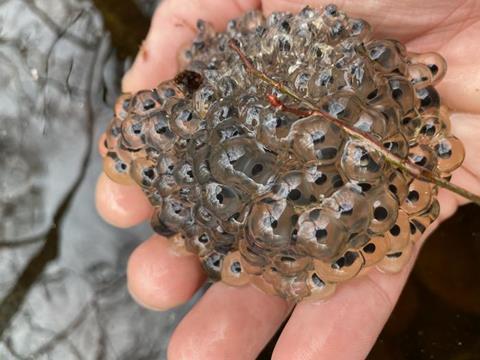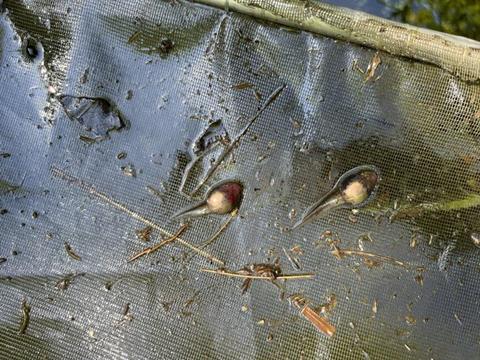The world’s amphibians are in trouble. Because of their sensitivity to climate change, habitat loss, and pollution, they may be the canary in the coalmine for the nascent anthropogenic mass extinction. Approximately 200 amphibian species have become extinct since the 1970s, and the International Union for the Conservation of Nature estimates that 34% of the 7,296 known remaining species are likewise at risk.

Another reason why amphibians are vulnerable is their susceptibility to disease. An emerging, potentially deadly disease of frogs and salamanders is ranavirus, a genus of at least seven species within the family Iridoviridae. Ranavirus can rapidly jump from host to host among fish, amphibians, and reptiles: a flexibility that can have catastrophic consequences, if new host species haven’t yet evolved any immunity.
But as a new study in Frontiers in Amphibian and Reptile Science has now shown, amphibians aren’t entirely defenseless against ranavirus.
“Here we show that in response to ranavirus, wood frog tadpoles change their growth, development, and resource allocation. This may help tadpoles tolerate the energetic demands of infection or escape risky environments to avoid infection entirely,” said Logan Billet, a PhD student at Yale University and the study’s first author.
Widespread threat
Ranavirus has been implicated in 40 to 60% of amphibian die-offs in the US. Infected larvae stop feeding and become lethargic, while swimming abnormally and bleeding internally. An outbreak often leads to the death of all larvae in a pond, and there is evidence that outbreaks are becoming more frequent due to climate change.
Between 2021 and 2023, the authors studied the growth and development of the wood frog Rana sylvatica in a forest in Connecticut. Wood frogs are so-called ‘explosive’ breeders in ponds formed from snowmelt. They compared three pond types: 35 which remained free from ranavirus over an entire season; seven which contained some infected tadpoles but saw little or no mortality; and five with an outbreak that killed off the entire cohort.

From mid-April to mid-July, the researchers regularly visited ponds to estimate the number of live and dead individuals. They collected up to 20 tadpoles from each and humanely euthanized them. In the laboratory, they determined the presence or absence of ranavirus in the liver of 1,583 of these with quantitative real-time PCR. They also measured the total length of 4,299 tadpoles and determined their developmental stage – the so-called Gosner stage, which ranges from zero for embryos to 42 for tadpoles on the brink of metamorphosis.
Life-history plasticity
Because of the life-history plasticity common to many amphibians, growth and development can vary independently: for example, tadpoles may grow slowly and thus be smaller than average, yet relatively large for their Gosner stage due to lagging development.
READ MORE: New edition of book explores ranavirus infection and disease in amphibians, reptiles and fish
READ MORE: Deadly frog disease more prevalent in central Florida than expected
The results showed that tadpoles in ‘die-off’ ponds at first grew significantly faster, which led to a larger body size over the first month of life. Tadpoles also matured faster in die-off ponds, being on average 0.38 stages ahead in their development. But once mass mortality started, the rate of growth and development in these pools crashed, so that they were overtaken in body size and stage by those in uninfected or uninfected ponds, and ended up small for their stage at their death from the disease.
Similarly, in infected ponds that ultimately saw no die-off, tadpoles grew significantly faster and developed precociously over the first month of life, so that they were larger in body size as well as on average 1.7 Gosner stages ahead of tadpoles in uninfected ponds.
Faster growth
The authors conclude that tadpoles respond to the presence of ranavirus by speeding up their growth rate and progressing through successive developmental stages faster early in life.
“Accelerating growth and resource allocation early on may allow tadpoles to improve their physical condition, and thus the strength of their immunity, in anticipation of infection. They might also metamorphose and move onto land earlier, potentially reducing their exposure to ranavirus,” said senior author Dr David Skelly, a professor at the Peabody Museum and Billet’s doctoral supervisor.
“These responses are likely to give tadpoles a survival advantage. We hypothesize they are the reason why mortality wasn’t always 100%, but only partial in some outbreaks in our study.”
“What we don’t yet know is how tadpoles detect ranavirus in their environment, for example through chemical or visual cues, and how effective these responses improve survival or tolerance of infection. Controlled experiments will be important to address these questions,” said Billet.







No comments yet